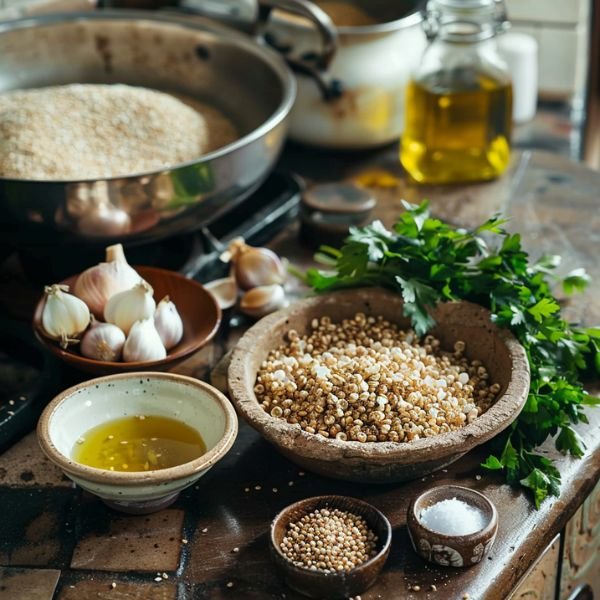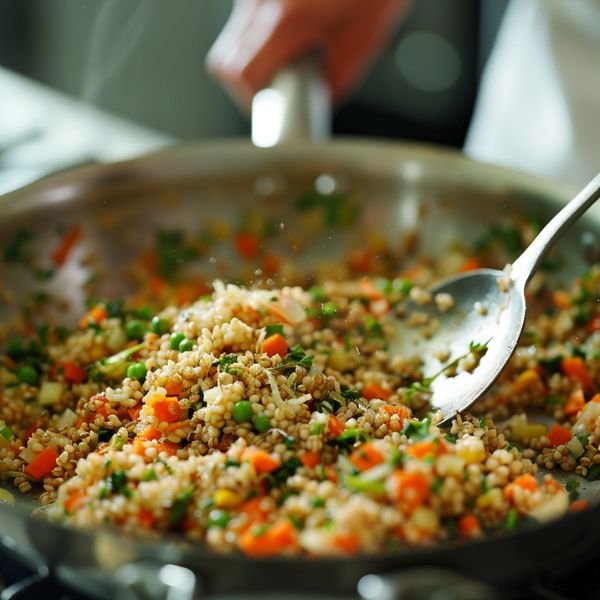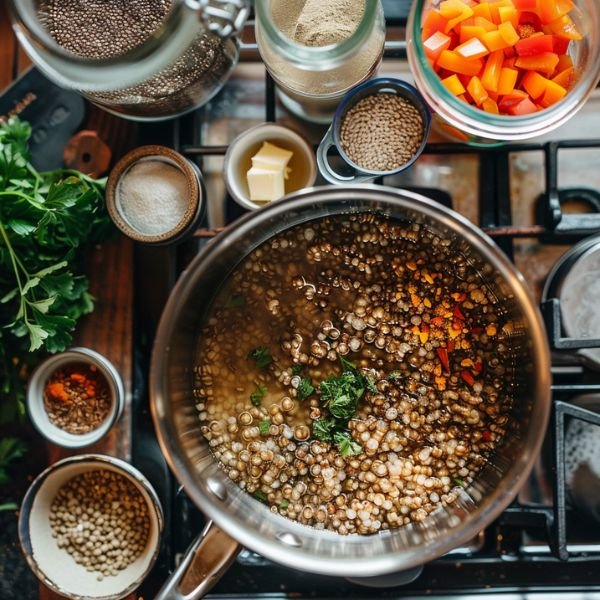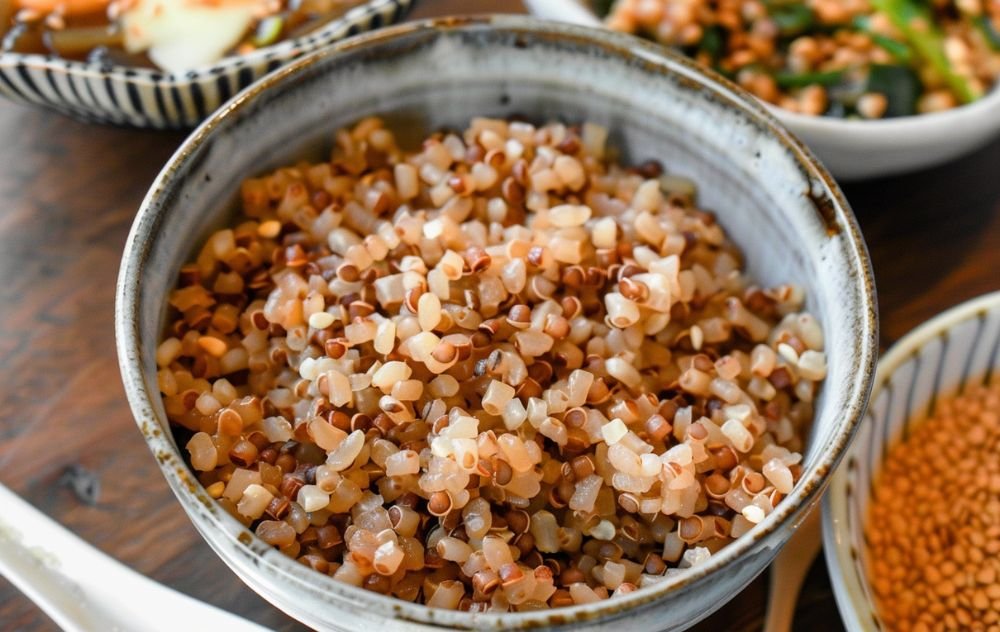Buckwheat rice is a gluten-free grain with nutrients and a unique, earthy flavor. It’s an excellent alternative to traditional rice, perfect as a side dish or base for hearty meals. Rich in health benefits, it supports heart health and digestion. This recipe highlights how to prepare buckwheat rice for the best flavor and texture.
The Inspiration Behind The Buckwheat Rice Recipe
The inspiration behind this buckwheat rice recipe comes from a desire to embrace nourishing whole grains that offer a rich, distinctive taste. Many traditional rice dishes sometimes lack flavour or nutritional value, especially compared to other grains. With its nutty aroma and chewy texture, Buckwheat rice offers a delightful, delicious, and highly nutritious alternative. Whether you want to diversify your grain options or follow a gluten-free lifestyle, this recipe is designed to highlight buckwheat’s versatility in a simple yet satisfying way. Inspired by international cuisines featuring buckwheat as a staple, this dish transforms an often-overlooked grain into a comforting, hearty side or main course.
Ingredients

To prepare this nutritious buckwheat rice recipe, you’ll need the following:
- 1 cup buckwheat groats
- 2 cups water or vegetable broth
- 1 tbsp olive oil or butter
- 1 small onion, finely chopped
- 2 garlic cloves, minced
- 1/2 tsp salt (optional, depending on broth used)
- 1/4 tsp black pepper
- Fresh parsley for garnish (optional)
Instructions
Step-by-Step Guide:
- Rinse the buckwheat groats: Place the groats in a fine mesh sieve and rinse under cold water to remove any impurities or dust.
- Toast the buckwheat (optional): For a nuttier flavor, heat a dry pan over medium heat and toast the groats for 3-4 minutes, stirring constantly.
- Sauté the aromatics: Heat olive oil or butter over medium heat in a medium saucepan. Add the chopped onion and garlic, and sauté for 2-3 minutes until fragrant.
- Cook the buckwheat: Add the rinsed (or toasted) buckwheat to the saucepan, stirring to coat with the oil. Pour in the water or broth, season with salt and pepper, and bring to a boil.
- Simmer: Reduce the heat to low, cover the saucepan, and let the buckwheat simmer for 12-15 minutes until the liquid is absorbed and the groats are tender.
- Fluff and garnish: Remove from heat and let it sit covered for 5 minutes. Fluff the buckwheat with a fork and garnish with fresh parsley before serving.
Variations

- Vegetable Add-Ins: Add chopped carrots, bell peppers, or peas to the pan when sautéing the onion and garlic for a colorful, veggie-packed dish.
- Herbed Buckwheat Rice: Stir in fresh herbs like dill, cilantro, or chives for an aromatic twist.
- Cheesy Buckwheat: Mix grated Parmesan or crumbled feta cheese for a creamy, savory variation.
- Spiced Version: Add spices like cumin, turmeric, or smoked paprika for an exotic flavor profile.
- Sweet Option: Cook buckwheat with almond milk, cinnamon, and a touch of honey for a breakfast or dessert alternative.
Cooking Notes
- Broth for flavor: Using vegetable or chicken broth instead of water adds depth and enhances the nutty flavor of buckwheat rice.
- Avoid overcooking: Overcooked buckwheat can become mushy, so check for doneness after 12 minutes.
- Toasting for extra flavor: Toasting the groats before cooking brings a more profound, nuttier taste.
Serving Suggestions
Buckwheat rice is a versatile dish that pairs well with a variety of meals:
- Serve as a side dish with roasted chicken, grilled fish, or tofu.
- Use it as a base for a hearty grain bowl, topped with sautéed vegetables and a drizzle of tahini sauce.
- Pair with a warm stew or curry for a comforting, complete meal.
- Add to salads for a nutritious lunch option.
Tips
- Make Ahead: Cook a large batch and store it in the fridge for up to 4 days or freeze it for quick meals.
- Rinse thoroughly: Always rinse the groats to avoid a bitter aftertaste.
- Fresh ingredients: garlic, onion, and herbs elevate the flavor.
Prep Time
5 minutes
Cooking Time
15 minutes
Total Time
20 minutes
Nutritional Information (per serving)
- Calories: 160
- Protein: 5g
- Carbohydrates: 28g
- Fiber: 4g
- Fat: 3g
- Sodium: 150mg
Tips for the Best Buckwheat Rice
1. Experiment with Cooking Liquids:
For more flavour, cook buckwheat in vegetable or chicken broth instead of water. You can add soy sauce or tamari splash to give the rice a savoury edge.
2. Try Different Seasonings:
If you enjoy experimenting with flavours, try seasoning your buckwheat rice with spices like cumin, turmeric, or curry powder. Fresh herbs like parsley, cilantro, or dill can also add a refreshing touch.
3. Make It a Meal:
Add your favourite protein (chicken, shrimp, or tofu) and vegetables to the buckwheat rice for a complete meal. A simple stir-fry or a vegetable-packed curry is a great way to make this dish hearty and filling.
4. Store Leftovers Properly:
If you have any leftover buckwheat rice, store it in an airtight container in the refrigerator. It can be reheated easily and is an excellent option for meal prep. Buckwheat rice also freezes well if you want to make a larger batch ahead of time.
The Health Benefits of Buckwheat Rice
Buckwheat rice is packed with essential nutrients like magnesium, copper, and essential amino acids, making it a powerful addition to your diet. Not only is it a gluten-free option for those with gluten intolerance or celiac disease, but it also provides numerous health benefits. Rich in antioxidants and fibre, buckwheat helps support heart health, improve digestion, and regulate blood sugar levels. It’s a great source of plant-based protein, making it an excellent choice for vegetarians and vegans looking to boost their nutrient intake.
Buckwheat Rice vs. Traditional Rice: A Nutritional Comparison
When comparing buckwheat rice to traditional white or brown rice, buckwheat stands out as a superior option. Unlike white rice, which is often stripped of nutrients during processing, buckwheat retains a rich nutrient profile. It contains higher amounts of magnesium, copper, and protein and offers more fibre, which aids digestion and supports overall health. Additionally, buckwheat has a low glycemic index, making it a healthier choice for those managing blood sugar levels. If you’re looking for a nutrient-dense alternative, buckwheat rice offers a compelling option over conventional rice.
How to Make Buckwheat Rice Even More Flavorful

Buckwheat rice has a naturally nutty flavour, but you can elevate it by adding seasonings, herbs, and other ingredients. Try sautéing the grains in unsalted butter or olive oil for added richness, or experiment with spices like cumin, turmeric, or paprika to create different flavour profiles. You can also add onions, garlic, bell peppers, or even toasted nuts and seeds to give it a crunchy texture. For extra depth, cook the buckwheat rice in vegetable or chicken broth instead of water to infuse more flavour into the grains.
The Versatility of Buckwheat Rice in Various Cuisines
One of the best things about buckwheat rice is its incredible versatility across different cuisines. Whether preparing a hearty Eastern European dish like buckwheat kasha or creating a flavorful Asian-inspired bowl with soba noodles, buckwheat rice can adapt to various cooking styles and ingredients. It pairs beautifully with roasted vegetables, meats, or even tofu, making it a perfect component of vegan and non-vegan meals. Buckwheat rice can easily take on different spices, seasonings, and sauces, making it a go-to ingredient for international dishes.
Meal Prep with Buckwheat Rice: Quick, Healthy, and Convenient
Buckwheat rice is perfect for meal prepping. With a short cooking time of just 15-20 minutes, you can easily make a large batch of buckwheat rice and store it in the fridge for the week ahead. Whether adding it to salads or grain bowls or using it as a side dish for your lunches and dinners, it offers a quick, healthy, and convenient base. It’s also great for batch-cooking and freezing, allowing you to have a nutritious, gluten-free meal ready whenever needed.
Buckwheat Rice for Special Diets: A Perfect Gluten-Free Option
Buckwheat rice is an excellent choice if you’re following a special diet due to gluten intolerance or celiac disease. Unlike traditional grains like white rice or brown rice, buckwheat is naturally gluten-free. It’s a nutrient-dense grain that offers a safe alternative and provides a wealth of essential nutrients such as magnesium, copper, and fibre. It’s ideal for those who want to reduce their gluten intake while enjoying a hearty, flavorful side dish or meal base.
How to Store and Reheat Buckwheat Rice for Maximum Freshness
Storing and reheating buckwheat rice is incredibly simple, making it an excellent option for meal prep. Once cooked, store your buckwheat rice in an airtight container in the refrigerator for up to 4-5 days. Add a small splash of water or broth, cover, and microwave or reheat in a pan over low heat until warm. You can also freeze buckwheat rice in portions for up to a month, making it easy to have a nutritious, gluten-free side dish ready anytime.
Conclusion
Incorporating buckwheat rice into your diet is a fantastic way to boost nutrition while adding a flavorful twist to traditional meals. Whether you’re avoiding gluten, managing a gluten intolerance, or simply looking for a nutritious alternative to white rice or brown rice, buckwheat rice is an excellent source of nutrients. Packed with essential amino acids, magnesium, copper, and fibre, it offers numerous health benefits, from supporting heart health to improving digestion. Buckwheat rice can be prepared in various ways, making it a versatile side dish or base for many recipes. With its quick cooking time and ability to pair with nearly any dish, buckwheat rice is a convenient and satisfying option that deserves a regular spot in your kitchen.
FAQ
How do I cook buckwheat groats to make buckwheat rice?
To cook buckwheat groats, rinse them under cold water to remove excess starch. Then, toast the buckwheat groats in a dry skillet over medium heat for 3-4 minutes until they become lightly golden and release a nutty fragrance. After toasting, cook the buckwheat with a water ratio 2:1 (2 cups of water for 1 cup of buckwheat groats). Bring it to a boil, then reduce the heat to low, cover, and simmer for 15-20 minutes until the water is absorbed and the buckwheat is tender.
Can I use raw buckwheat to make buckwheat rice?
Yes, you can use raw buckwheat to make buckwheat rice. It’s essential to rinse the raw buckwheat thoroughly before cooking. Before cooking, toast the buckwheat in a dry skillet over medium heat for a deeper flavour.
How can I prevent mushy buckwheat when cooking?
To avoid mushy buckwheat, use the correct water ratio and prevent overcooking. The standard water ratio for buckwheat rice is 2 cups of water to 1 cup of buckwheat. After cooking, let it sit covered for a few minutes before fluffing with a fork to prevent the grains from sticking together.
Is buckwheat rice a good alternative for people with gluten intolerance or celiac disease?
Buckwheat rice is an excellent choice for gluten intolerance or celiac disease patients. Unlike white rice, brown rice, or other grains, buckwheat is naturally gluten-free, making it a safe and nutritious option for individuals with gluten sensitivities.
Can I use buckwheat rice in dishes like soba noodles or buckwheat kasha?
Absolutely! Buckwheat rice can be used in dishes similar to soba noodles or buckwheat kasha. You can incorporate it as a substitute for traditional rice in stir-fries, curries, or even salads. The nutty flavour of buckwheat pairs well with many ingredients and seasonings, making it versatile for both savoury and sweet dishes.






